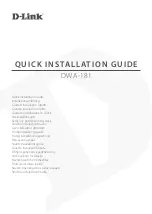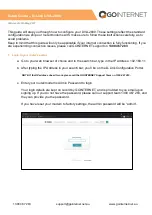
42
www.cooperbussmann.com/wirelessresources
Cooper Bussmann 945U-E Wireless Ethernet Modem & Device Server User Manual
Rev Version 2.14
The example in Figure 36 demonstrates how a Modbus/TCP client (master) can connect to one or more Modbus
RTU (serial) slaves. In this example the 945U-E access point is configured with the “RS232 Modbus/TCP to RTU
Gateway” enabled. Once enabled, the gateway converts the Modbus/TCP queries received from the master into
Modbus RTU queries and forwards these over the RS232 port to the slave. When the serial response to the query
arrives from the slave, it is converted to a Modbus/TCP response and forwarded via the network to the Modbus/
TCP master. If no response was received serially by the 945U-E within the configured Response Timeout, the
945U-E will initiate a number of retries specified by the configured Maximum Request Retries.
The Modbus TCP to RTU gateway may be configured to operate on either the RS 232 or RS 485 port.
3.11 Serial Menu
RS-232 / RS485 Serial Port Configuration
RS232 Port
Select the desired functionality. Select either PPP, Serial Gateway or Modbus TCP to
RTU.
Data Rate
The serial data rate desired. Serial data rates available range from 110 bps to a
maximum of 115,200 bps.
Data Format
The data format desired. All the standard data formats are supported.
Flow Control
Select CTS/RTS or None.
RS232 PPP Server (Only RS232)
Username
User name to enter to access RS-232 PPP server.
Password
Password to access RS-232 PPP server.
Local IP Address
Select the IP address of the PPP server. The remote device may be made visible on
the Ethernet or wireless networks by either utilizing proxy-arp or routing. The proxy-
arp feature may be enabled by setting the local IP address the same as the Ethernet
IP address or the wireless IP address. The module will respond on behalf of the
remote device, making it seem like the device is present on the configured network.
Alternatively, if the IP address selected is not the same as the Ethernet or wireless IP
address, routing is used to pass data to the Ethernet and wireless ports.
Remote Device IP
Address
Select the IP address of the remote device. Ensure this address is not the same as
any other device on the Ethernet or wireless networks.
RS-232 / RS485 Serial Gateway Mode
Serial Gateway Mode
Server—Module will wait for a connection to be initiated by a remote client.
Character Timeout
Enter the maximum delay (in msec) between received serial characters before the
packet is sent via network.
Packet Size
The number of received bytes that will be buffered before a packet is sent via the
network.
Listen Port (Server)
Server only. Enter the TCP port number on which the server must listen for incoming
connections. The standard TELNET port is 23.
Serial Gateway Mode
Client—Module will automatically attempt to connect to the specified remote server.
Character Timeout
Enter the maximum delay (in msec) between received serial characters before the
packet is sent via network.
Packet Size
The number of received bytes that will be buffered before a packet is sent via the
network.
















































